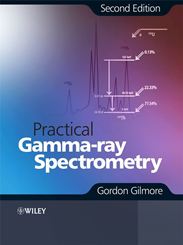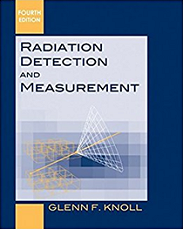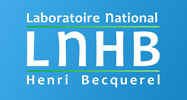Useful links
Working Group Web Pages and ICRM information
- ICRM Main site
- ICRM Newsletter
- Radionuclide Metrology Techniques
- Liquid Scintillation Counting
- Non-Neutron Nuclear Data
Metrological and other related Institutions
- BIPM, Bureau International des Poids et Mesures, France
- EURAMET, European Association of National Metrology Institutes
- IAEA, International Atomic Energy Agency, Austria
- CIEMAT, Centro de Investigaciones Energéticas, Medioambientales y Tecnológicas, Spain
- CEM, Centro Español de Metrología, Spain
- CNEA, Comisión Nacional de Energía Atómica, Argentina
- NMISA, National Metrology Institute of South Africa
- CMI, Czech Metrological Institute, Czech Republic
- IRA-METAS, Institut de Radiophysique, Switzerland
- IRD, Instituto de Radioproteção e Dosimetria, Brazil
- JRC-Geel, Belgium
- ENEA, Istituto Nazionale di Metrologia delle Radiazioni Ionizzanti, Italy
- NMIJ, National Metrology Institute of Japan
- NIM, National Institute of Metrology, China
- CEA, Commissariat à l’Énergie Atomique et aux Énergies Alternatives, France
- LNE, Laboratoire National de métrologie et d’Essais, France
- LNHB, Laboratoire National Henri Becquerel, France
- NIST, National Institute of Standards and Technology, USA
- NPL, National Physical Laboratory, UK
- PTB, Physikalisch-Technische Bundesanstalt, Germany
Norms
Different norms are linked to gamma-ray spectrometry calibration and measurement, established by IEC, ISO or IEEE in different technical committees (TC).A summary of IEC standards prepared by WG9 of the TC 45, is given in this presentation.
- IEC 60973:1989 – Test procedures for germanium gamma-ray detectors
- IEC 61435 – High-purity germanium crystals for radiation detectors – Measurement methods of basic characteristics
- IEC 61452 Ed.1.0 – Measurement of gamma-ray emission rates of radionuclides – Calibration and use of germanium spectrometers (In revision)
- ISO 10703:2007 – Water quality — Determination of the activity concentration of radionuclides — Method by high resolution gamma-ray spectrometry
- ISO 18589-3:2015 – Measurement of radioactivity in the environment — Soil — Part 3: Test method of gamma-emitting radionuclides using gamma-ray spectrometry
- ISO 19017:2015 – Guidance for gamma spectrometry measurement of radioactive waste
- ISO 19581:2017 – Measurement of radioactivity — Gamma emitting radionuclides — Rapid screening method using scintillation detector gamma-ray spectrometry
- ISO 20042:2019 Measurement of radioactivity — Gamma-ray emitting radionuclides — Generic test method using gamma-ray spectrometry
- IEEE N42.14-1999 – American National Standard for Calibration and Use of Germanium Spectrometers for the Measurement of Gamma-Ray Emission Rates of Radionuclides
- IEEE 63147-2017 – IEEE/IEC International Standard – Criteria for accident monitoring instrumentation for nuclear power generating stations
Practical information
Basic bibliography
- Practical Gamma-Ray Spectrometry, 2nd Edition
Author: Gordon Gilmore
April 2008
Publisher: Wiley
This is completed by the web site: http://www.gammaspectrometry.co.uk/index.htm; however this page is no more maintained since late 2014. - Radiation Detection and Measurements, 4th Edition
Author: Glenn F. Knoll
January 2010
Publisher: John Wiley & Sons, Inc.
- Gamma-Ray and X-Ray Spectrometry with Semiconductor Detectors
Authors: Klaus Debertin and Richard G. Helmer
January 1989
Publisher: North Holland, 1988 - Nuclear decay database
According to the 3NDWG meeting of 7 september 2005, the atomic and nuclear decay data contained within Monographie BIPM-5 are recommended to ICRM members and co-workers for their future decay data studies.
The work involved in evaluating nuclear data is on-going and the recommended values are updated on the LNHB website.
Gamma ray spectra
An on-line library of gamma ray spectra is maintained by Idaho National Laboratory – Gamma Spectrometry Center. « The INL’s Gamma-ray Spectrum Catalogue is an attempt to compile spectra from various detector types and present these spectra with decay schemes and data tables based on the latest ENSDF data. It includes recently acquired Ge spectra and decay data as well as available spectra acquired for the original NaI(Tl) and Ge(Li) Catalogues. All information is documented by the spectra acquisition date and the ENSDF download date.
(http://www4vip.inl.gov/gammaray/catalogs/ge/catalog_ge.shtml)
Software
Hereafter is included a list of software that can be useful for gamma-ray spectrometrists. This is given only for information purposes and citation does not mean that the working group recommends or supports these software. Any hyperlinks are only given for convenience and do not imply any support from the working group.
Efficiency transfer and self-attenuation corrections
- ANGLE: www.dlabac.com/angle
- EFFTRAN (Efficiency transfer and true coincidence summing corrections for environmental gamma-ray spectrometry)
https://efftran.github.io/ - ETNA is a software for computing efficiency transfer and coincidence summing corrections for gamma-ray spectrometry. The attached file (NT_Doc_etna_eng.pdf) presents the software facilities and includes a user’s manual.
A short practical presentation is attached here.
The software has been developed at the Laboratoire National Henri Becquerel and is available upon request.
Contact: Marie-Christine Lépy at LNHB - GESPECOR (Germanium Spectroscopy Correction Factors)
Contact: Octavian Sima (Bucharest University)
Coincidence summing corrections
- EFFTRAN (Efficiency transfer and true coincidence summing corrections for environmental gamma-ray spectrometry)
https://efftran.github.io/ - GESPECOR (Germanium Spectroscopy Correction Factors)
Contact: Octavian Sima (Bucharest University) - ETNA is a software for computing efficiency transfer and coincidence summing corrections for gamma-ray spectrometry. The attached file (NT_Doc_etna_eng.pdf) presents the software facilities and includes a user’s manual.
A short practical presentation is attached here.
The software has been developed at the Laboratoire National Henri Becquerel and is available upon request.
Contact: Marie-Christine Lépy at LNHB
Decision-threshold and detection-limit calculator
Since the standard ISO 11929-1:2019 “Determination of the characteristic limits (decision threshold, detection limit and limits of the coverage interval) for measurements of ionizing radiation – Fundamentals and application” requires reporting of characteristic limits for all measurands of interest, regardless whether their presence in the spectrum was recognized or not, the Laboratory for High Resolution Gamma-ray Spectrometry (Josef Stefan Institute) developed a simple Excel tool (The Calculator) for calculating the decision thresholds and detection limits for gamma-ray emitters from high-resolution gamma-ray spectra. This is kindly accessible to the community engaged in gamma-ray spectrometry measurements.The main features of the software can be found on the laboratory web site (See Useful Applications).
- The Calculator is available for downloading at: https://f2.ijs.si/en/laboratories/lmr/calculator
At the site four files are available:
• the description and explanation of the methods implemented in the tool, and the user’s guide,
• the tool itself, which is a small Excel file,
• the description of the application of the tool on an example spectrum, together with the results, in order to enable the user to check if he uses the tool properly,
• the example spectrum in the Canberra’s .CNF format.
Tool for spectrum transfer
- SPECON is a converting utility between various spectrum files having various binary formats. It can automatically identify 11 binary formats and three ASCII formats. They can be completely converted to each other including experimental information if possible. This software is also useful as a spectrum viewer.
http://specon-2000.software.informer.com
Monte Carlo simulation of spectra and efficiency
- Software package MCC-MT (Monte Carlo Calculation Multi Thread) is intended for 3D-modelling of physical experiments and calculation of radiation detectors response functions using Monte Carlo simulation method.
https://www.tals.eu/mcc-mt
Preparation of PENELOPE geometry files
- PUFI (PENELOPE User-Friendly Interface) is a convenient interface designed to facilitate the preparation of PENELOPE geometry files for application to gamma-ray spectrometry. The software considers typical cases with a cylindrical geometry including detector, volume source and shielding.
The software has been developed at the Laboratoire National Henri Becquerel and can be downloaded here.
Peak fitting
- COLEGRAM purpose is to accurately process experimental spectra to separate overlapping components and derive individual areas for each of them, especially in the 100 keV photon energy region including both X-ray and gamma-ray peaks. The processing of different types of spectra is achieved by fitting mathematical functions to experimental data sets. Several types of functions can be used, depending on the kind of spectrum; most of them are specific to a particular peak shape: alpha, gamma, X, or beta. Functions for overall background shapes such as exponential or polynomial, are also available. COLEGRAM uses the least squares fitting method with the Marquardt-Levenberg algorithm and is based on a visual management under the user’s control.
The attached file (NT_Colegram.pdf) presents the software facilities and its practical use.
The software has been developed at the Laboratoire National Henri Becquerel and is available upon request.
Contact: Marie-Christine Lépy at LNHB
Attenuation coefficients
- XCOM: Photon Cross Sections Database
M.J. Berger, J.H. Hubbell, S.M. Seltzer, J. Chang, J.S. Coursey, R. Sukumar, and D.S. Zucker
A web database is provided which can be used to calculate photon cross sections for scattering, photoelectric absorption and pair production, as well as total attenuation coefficients, for any element, compound or mixture (Z = 100), at energies from 1 keV to 100 GeV.
http://physics.nist.gov/PhysRefData/Xcom/Text/XCOM.html
Uncertainties
- Uncertainties in gamma-ray spectrometry, M.-C. Lépy, A. Pearce and O. Sima, Metrologia 52 (2015) S123-S145
Bibliography by topics
The attached files include a non-exhaustive list of published articles in relation with the main topics.
Coincidence summing
- The attached file (Coincidence_summing_Biblio.pdf) gathers around 50 references sorted in the publication dates. They present either theoretical or practical methods, or experimental validations.
This is only a list without any judgment about the quality of the quoted articles.
Monte Carlo methods applied to efficiency computation
- The attached file (Monte_Carlo_Efficiency_Biblio.pdf) gathers around 20 references sorted in the publication dates.
This is only a raw list without any judgment about the quality of the quoted articles.
Training material
The hereafter attached PDF files are presentations that have been used for the purpose of training.
